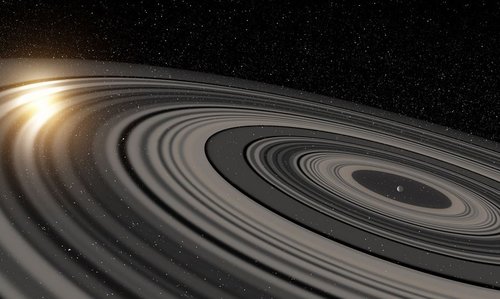Scientists at the University of Rochester, USA, and Leiden Observatory, The Netherlands, discovered a massive ring system that eclipses the very young Sun-like star J1407. The ring system is estimated to be about 200 times bigger and heavier than the one that surrounds Saturn.
The ring system, discovered in 2012 by a Rochester team, is the first to be found outside our solar system.
In a new analysis of the data, Leiden’s Matthew Kenworthy and team showed that the system comprises 30 rings – each one with a diameter of tens of millions of kilometers.
The scientists also found gaps in the rings, which suggests than “exomoons” (satellites) may have formed. Their findings have been accepted for publication in the Astrophysical Journal.

Artist’s impression of the extrasolar ring system orbiting the young giant planet or brown dwarf J1407b. The rings are shown eclipsing the young sun-like star J1407, as they would have appeared in early 2007. (Credit: Ron Miller. Image: University of Rochester)
Kenworthy said:
“The details that we see in the light curve are incredible. The eclipse lasted for several weeks, but you see rapid changes on time scales of tens of minutes as a result of fine structures in the rings. The star is much too far away to observe the rings directly, but we could make a detailed model based on the rapid brightness variations in the star light passing through the ring system.”
“If we could replace Saturn’s rings with the rings around J1407b, they would be easily visible at night and be many times larger than the full moon.”
Professor of physics and astronomy at the University of Rochester, Eric Mamajek, who is also co-author of the study, said:
“This planet is much larger than Jupiter or Saturn, and its ring system is roughly 200 times larger than Saturn’s rings are today. You could think of it as kind of a super Saturn.”
The astronomers gathered and analyzed data from the SuperWASP project – a survey designed to detect gas giants that move in front of their parent star.
In 2012, Mamajek and his team at the University of Rochester reported they had discovered the young star J1407 and the unusual eclipses. They suggested they were caused by a moon-forming disk around a brown dwarf (between a giant planet and a small star) or young giant planet.
In a third, more recent study which Kenworthy also led, the mass of the ringed object was estimated with the use of adaptive optics and Doppler spectroscopy.
Based on their analysis of these and previous papers, the astronomers concluded that the intriguing system J1407’s companion is probably a giant planet that has not yet been detected, with a huge ring system responsible for the repeated dimming of J1407’s light.
The ring system’s diameter is nearly 120m km
From analyzing the light curve, the astronomers have estimated that the diameter of the ring system is almost 120 million kilometers, making it over 200 times larger than the rings of Saturn. The ring system probably contains about an Earth’s worth of mass in light-obscuring dust particles.
Mamajek said, regarding the amount of material contained in these disks and rings:
“If you were to grind up the four large Galilean moons of Jupiter into dust and ice and spread out the material over their orbits in a ring around Jupiter, the ring would be so opaque to light that a distant observer that saw the ring pass in front of the sun would see a very deep, multi-day eclipse.”
“In the case of J1407, we see the rings blocking as much as 95 percent of the light of this young Sun-like star for days, so there is a lot of material there that could then form satellites.”
The astronomers found at least one clean gap in the ring structure, which is more clearly defined in the new model.
Kenworthy said:
“One obvious explanation is that a satellite formed and carved out this gap. The mass of the satellite could be between that of Earth and Mars. The satellite would have an orbital period of approximately two years around J1407b.”
The authors believe that the rings will get thinner and thinner over the next several million years and eventually disappear as the material in the disks form satellites.
Mamajek explained:
“The planetary science community has theorized for decades that planets like Jupiter and Saturn would have had, at an early stage, disks around them that then led to the formation of satellites. However, until we discovered this object in 2012, no-one had seen such a ring system. This is the first snapshot of satellite formation on million-kilometer scales around a substellar object.”
The ringed companion J1407b probably has an orbital period of approximately a decade in length, the astronomers estimate.
The mass of J1407 is likely to be in the range of about 10 to 40 times that of Jupiter, the scientists estimated.
The researchers are inviting amateur astronomers to help monitor J1407, which would help detect the next eclipse of the ring, and measure the period and mass of the ringed companion. Observations can be reported to AAVSO (American Association of Variable Star Observers).
Kenworthy explained that finding eclipses from objects like J1407’s companion “is the only feasible way we have of observing the early conditions of satellite formation for the near future. J1407’s eclipses will allow us to study the physical and chemical properties of satellite-spawning circumplanetary disks.”
Video – Exoring model for J1407b
